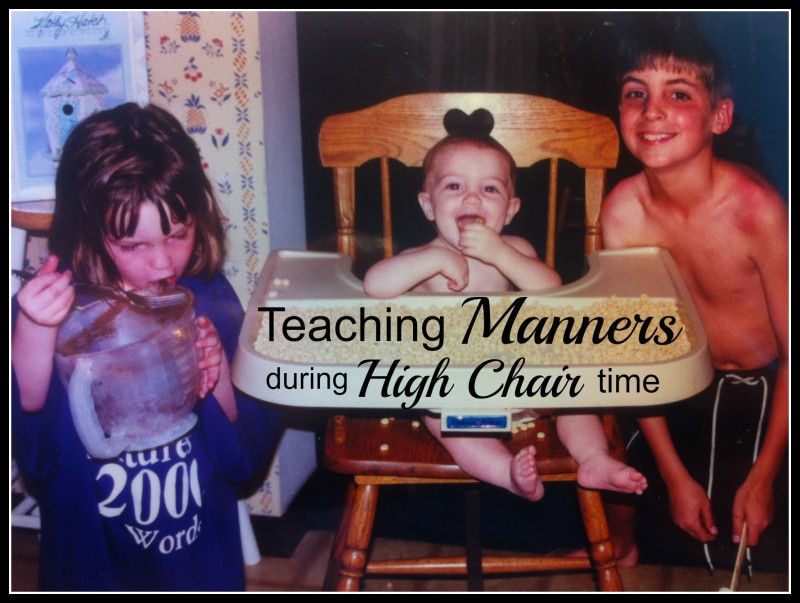
Should I be disqualified from teaching on high chair training and manners? This blast from the past shows a child eating brownie mix, box of Cheerios spilled and covering the highchair tray and beyond, shirtless children, and laughter abounding in the home as we take one day at a time, trying to parent to the heart and somehow teach manners along the way.
Teaching manners during high chair time
Observing a child in a high chair at meal time can reveal much about … our parenting.
- Does child grunt to communicate more food
- Does child yell, scream, or whine to communicate dissatisfaction
- Does child drop the sippy cup over and over again…because each time its picked up
- Does child sit still while sitting in the high chair
- Does child make mess all over face, body, clothing, chair, and floor
- Does child put hands in food and smear onto high chair tray
- Does child demand attention while eating
- Does child communicate loudly
- Can child sit still (relatively speaking) during the duration of family meal time without causing stress to you or the other family members?
Does your child control you? Using the high chair time to effectively teach manners can turn things around. That’s great news!
Routine meal times are significant to training
Having a routine of meal time together is significant. It is here – when your young child is sitting in the high chair- that significant training of manners, communication, behaviors, and obedience can be taught. It is here that standards within your home can be learned- such as voice level and tone, cleaning up a mess, responding to accidents, and establishing the discipline to sit still and listen. It is here that your child can learn the world doesn’t revolve around them and they are not going to control your actions (picking up the sippy cup over and over) nor will they communicate with grunts and yelling.
At first, when the child is very young and just able to sit up in the high chair, we spoon feed the child, being careful to scrape the food surrounding the mouth back onto the spoon and into the mouth. When the child reaches for the spoon or her mouth we gently move her hand to stay clear of making a mess. The child may use her hands to pick up dry cereal or various foods, but we are teaching her to not put her hands in the messy foods.
Sitting with the child during feeding is such a valuable time of intentional training. This is where you are singing to, talking to, having eye contact, smiling, and teaching manners. You are teaching how your family operates at meal time. As tempting as it is to leave the child and sweep the floor and load the dishwasher, you don’t want to miss out on establishing important routines and standards and even tones in your home.
Before too long, the child is reaching for the spoon and is ready for you to teach proper handling of it. Don’t leave her unattended to figure this out alone, but rather put her little hand around the handle and hold her hand on hers, teaching her not only spoon handling skills but manners. Your training at this stage will pay off and before you know it, the child will be able to handle use of the spoon on her own and eat neatly as well. (You will even be able to get up and tend to something without coming back to a disaster.)
Consider this. It’s quite common to put the peas and various foods directly onto the high chair tray, allowing the child to smear the food on the tray, on her body, all over the chair and floor. You may have just never thought about there being an alternative to the routine hosing down and backhoe needed to clean up your child and the tray after each sitting. Children are capable of learning to eat with manners from the beginning. I’m not saying messes won’t be made, but consider that it is a work in progress. With you sitting there guiding, correcting, talking with and showing proper skills, your child will be able to eat neatly and skillfully in a relatively short amount of time. I suggest using a plate. This can be what everyone else is using (meaning a breakable plate, china, or simply a paper plate) or your child may have his own fun special plastic plate. Put small amounts of the food directly onto the plate. While sitting there you’re teaching not to put hands in messy foods and not to pick up the plate and throw it. Gentle, consistent guidance is the goal during this intentional training during sessions with just you and your child or family meal time (and snack time).
Tomorrow I’m talking about using the high chair time as an intentional time of interaction.
Just in case I’ve sent an unintended message that parenting is easy if you follow steps A, B, and C or that my home was so quiet and lovely at all times, I thought I’d share this picture I found while looking for high chair photos. Keep on parenting and enjoying (and capturing) the funny moments along the way.
Rhonda getseriousaboutoneononetrainingduringhighchairtime ellis

